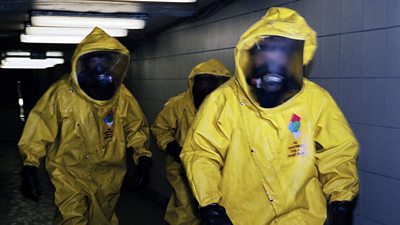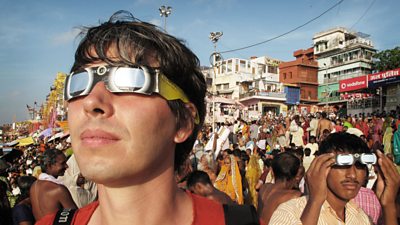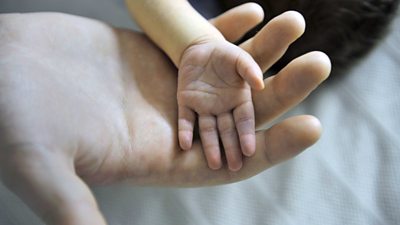Note: Laser radiation is covered in a separate guideline (see Laser Lighting Effects in Related Topics).
What can go Wrong?
Dependent on their wavelength, energy levels, proximity to human tissue and exposure times, these radiant energy sources are capable of:
- skin tissue damage, including burns (e.g. sunburn from UV sunlight)
- deeper tissue damage, due mainly to penetrative heating (e.g. some radio frequencies, microwaves, etc)
- eye damage where the radiant energy penetrates the eye (e.g. UV or infra-red light from high voltage arc lamps, laser light)
- possible interference with control circuits on life-critical equipment (e.g. RF and EMF affects on pacemakers)
- unspecified affects on body tissue when exposed to high electromagnetic fields (e.g. working close to high voltage power lines).
As their name suggests, non-ioninsing radiation doesn't have the energy levels to ionise atoms on impact, but carcinogenic effects are thought by some to be induced by other secondary physiological and chemical effects within the body, particularly following high exposures to RF and microwaves.
Measuring exposure levels of these radiant energy sources and then predicting exposures is a specialist task using highly technical equipment.
Legal/91�ȱ� Requirements
- can be downloaded for free
- can also be downloaded for free.
Control Measures
Beyond avoiding exposure altogether (which is the best form of control), the basic precautions to minimise exposure to non-ionising radiation is:
- Time - minimise how long you are exposed to the energy source
- Distance - keep as far from it as you can
- Shielding - for optical energy sources, put an energy absorbing or reflecting barrier between it and you (e.g. sunscreen for UV)
- Reduce energy levels - where you can, use equipment or work in areas where the energy levels are as low as posisble.
The following precautions are all based on these basic principles.
Radio Frequency
- Do not use any equipment which may generate RF frequencies in mines or other places which may have electrically fired explosives present.
- Discuss with your manager and seek advice if you have a medical device such as a pacemaker that might be affected by non-ionising radiation
Mobile phones
- Exposure to radio waves may be minimised by keeping calls short, using hands free devices or texting.
Radio cameras
- High power should only be used if necessary. When on high power do not use the camera underarm.
- On low power the antenna should be at least 1cm from any part of the body and at high power the antenna should be at least 6cm from any part of the body. If used this way this equipment is within EU exposure limits.
- The equipment has been maintained and tested in accordance with manufacturers guidance..
- This equipment must not be used in areas where the use of RF equipment is prohibited. (e.g. where a no mobile phone use sign is displayed).
- Deployment of this camera / link is subject to the same safety planning considerations as for normal camera operations.
Staff working on or near mast or dish capable of transmitting
- The height and direction of the dishes normally precludes the likelihood of anyone being exposed to harmful levels of radiation. This should be considered before operating any dishes.
- Display warning signs in line with training received in safe use.
- Use sat phones in accordance with manufacturer’s instructions e.g. set up so that people are not in the direct path of the waves which are transmitted in a cone shaped path from the equipment.
- Check line of sight when setting up “dishes” for any person who may accidentally move into a danger zone.
- Obtain information about safe working areas from owners of buildings.
Nera / Bgan
- Keep area clear 1 metre in front of the device to avoid non ionising radiation field emitted in a tight cone in front of kit.
Thuraya / iridium phones
- Open antenna and use with antenna pointing towards sky.
SIM Card Devices (Live U / WMT)
- Use SIM card transmission devices in accordance with the manufacturers and Newsgathering guidelines.
Optical, including artificial optical radiation
- The eye’s aversion response is effective for most optical wavelengths but additional protection is required to protect especially from ultraviolet.
- HMI lights can emit harmful levels of ultraviolet light – ensure that a UV filtering gel is always used with portable HMI lights or whenever you cannot prove that UV is not being emitted.
- Avoid prolonged exposure to strong sunlight. If working outside in strong sunlight use high SPF creams and wear long clothing.
- Display and High-power lasers must only be supplied and operated by a competent contractor that have robust plans to manage the display put those plans are put into effect. See Display Laser guidance for more information.
- Arc welding can produce intense UV radiation and intense visible and IR radiation from the arc. Seek guidance about the appropriate eye protection if filming or recording these activities.
Other EMF Fields
- Field measurements can be arranged if it is suspected that high field strengths may create a hazard.
Division Specific Issues
- No division specific issues.
FAQs/Did You Know?
- There have been incidents where people have suffered temporary damage to their eyes after working close to portable HMI lights for prolonged periods (i.e. several hours). A UV filtering gel fitted to the light could have prevented the harm.
- Non-ionising radiation (NIR) is the part of the electromagnetic spectrum covering optical radiation (ultraviolet (UV), visible and infrared) and electromagnetic radiation (power frequencies, microwaves and radio frequencies).
Recommended links
Skin and eyesight risk topics
-

CBRN and Industrial Spills
A guide to chemical, biological and radiation related hazards. -

Display Screen Equipment (DSE)
A safety guide to various types of workstation and how to address any health issues. -

Laser Light Effects
Guidance to using laser on productions -

Non-Ionising Radiation
An overview of the risks from exposures to non-ionising radiation, including UV, microwaves and electro-magnetic fields (EMF). -

Skincare and Dermatitis
A guide to looking after your skin and recognising the symptoms of dermatitis which is a reaction that occurs when our skin becomes inflamed. -

Strobe Lighting
Safety Guideline to strobe lighting used as a visual effect for entertainment performances.
More from SSR
-
Your platform to record accidents, risk assessments, assurance monitoring and inspections
-
Safety Equipment Stores
Just one number to call: 020 3614 5155 -
91�ȱ� Safety Guidelines
An A-Z of 91�ȱ�'s Health and Safety Guidelines -
Safety Advice Line: 0370 411 0464 Email: safety@bbc.co.uk
Events guidance - key links:
- Exhibitions
- General Guidance
- Indoor Location Recce Checklist
- Outdoor Location Recce Checklist
- Major Incidents & Emergency Planning
- Marketing and Promotional
- Noise Exposure
- Planning and Management
- Responsibilities
- Responsibilities Form
- Laser Lighting Effects
- Strobe Lighting
- Temporary Stages and Rostra
Health topics - key links:
- (91�ȱ� network only)
- Contributors Fitness to Participate
- Display Screen Equipment (DSE)
- (91�ȱ� network only)
- First Aid and Welfare on Location
- International Travel - Risks & Health
- Manual Handling
- Mental Health: 91�ȱ�page
- (91�ȱ� network only)
- Personal Health and Wellbeing
- Pregnancy
- Psychological Trauma Support & Trauma Risk Management (TRiM)
- Tiredness and Fatigue
- Travel Health Contacts
91�ȱ� High Risk - key links:
- CBRN and Industrial Spills
- Covert Filming
- Crisis Management and Security Support
- Demonstrations, Protests and Crowds
- Disaster Coverage
- Door Stepping
- (91�ȱ� network only)
- (91�ȱ� network only)
- Public Order
- Safety Equipment Stores
91�ȱ� Journalism - key links:
91�ȱ� Productions - key links:
- Aerial Filming and Airfields
- Animals: Displaying and handling for performance
- Boats: Working on
- Children and Young People
- Driving
- Electrical Equipment and Systems
- First Aid and Welfare on Location
- Food Safety (Cooking and Catering)
- Remote Location Working
- Roads and Streets: Working by
- Security of Productions on Location
- Stunts
- Tiredness and Fatigue
- Unmanned Aerial Systems (UAS aka Drones)
- Vehicles: Recording in, from and around
- Working at Height: Mobile Elevating Work Platforms
- Working at Height: Tower Scaffolds
91�ȱ� Radio - key links:
- (91�ȱ� Network only)
91�ȱ� Security - key links:
91�ȱ� Sport - key links:
About this site
This site describes what the 91�ȱ� does in relation to managing its health, safety and security risks and is intended for those who work directly for the 91�ȱ�.
It is not intended to provide instruction or guidance on how third parties should manage their risks. The 91�ȱ� cannot be held liable for how this information is interpreted or used by third parties, nor provide any assurance that adopting it would provide any measure of legal compliance. More information
Some links on this site are only accessible when connected to the 91�ȱ� network
